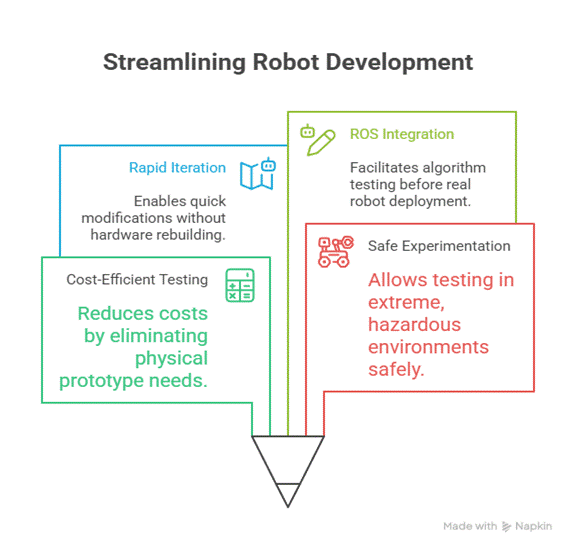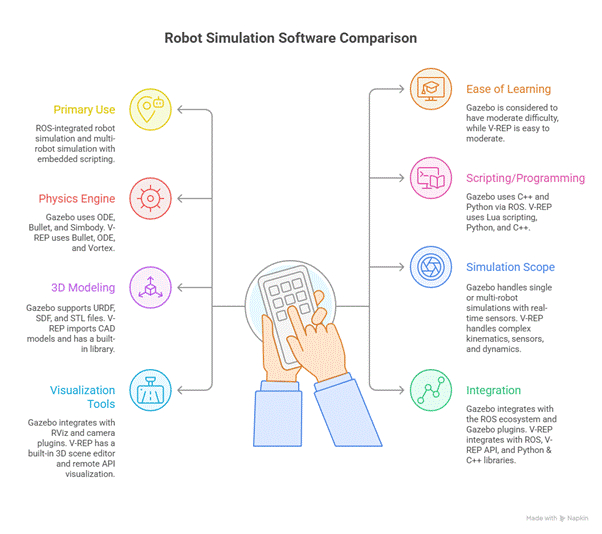Introduction
Simulation is a critical step in robotics development. Before deploying robots in the real world, engineers test designs, algorithms, and controls virtually to save time, resources, and avoid damage. Two of the most widely used robotics simulation platforms are Gazebo and V-REP (now called CoppeliaSim).
At CuriosityTech.in, learners can explore simulation tutorials that guide beginners from basic virtual robot modeling to complex autonomous system testing, ensuring that theoretical learning seamlessly transitions into practical implementation.
1. Importance of Simulation in Robotics

2. Overview: Gazebo vs V-REP (CoppeliaSim)

3. Gazebo: Features and Applications
- Physics Simulation: Realistic gravity, collision, and sensor interaction.
- Robot Models: Use URDF or SDF files to define robot structure.
- Sensor Simulation: LiDAR, cameras, IMU, and more.
- Integration: Seamless with ROS for node-based communication.
- Practical Project Example:
- Simulate a line-following robot using Gazebo.
- Use ROS nodes to subscribe to camera or LiDAR topics.
- Test obstacle avoidance algorithms without real hardware.
- Simulate a line-following robot using Gazebo.
CuriosityTech.in provides tutorials to export Gazebo simulations into real-world robots after testing algorithms virtually.
4. V-REP / CoppeliaSim: Features and Applications
- Embedded Scripting: Lua-based scripts for robot control within simulation.
- Multi-Robot Support: Simulate multiple robots interacting in complex environments.
- Remote API: Control robots externally using Python or C++.
- Physics Engine Options: Choose Bullet, ODE, or Vortex for customized simulations.
- Practical Project Example:
- Simulate a 6-DOF robotic arm picking and placing objects.
- Integrate motion planning algorithms to optimize pick-and-place operations.
- Test sensors, cameras, and robot dynamics virtually.
- Simulate a 6-DOF robotic arm picking and placing objects.
6. Advantages of Simulation for Learning
- Rapid Skill Development: Beginners can practice ROS, AI algorithms, and motion planning without hardware.
- Safety: Test robots in hazardous or extreme scenarios.
- Experimentation: Change sensors, actuators, and algorithms quickly.
- Integration Skills: Learn how to combine ROS nodes, sensors, and actuators in a virtual environment before real deployment.
Practical Tip: Start with Gazebo for ROS-integrated projects and use V-REP for complex multi-robot or industrial robot simulations.
7. Recommended Beginner Projects
- Mobile Robot Navigation: Test obstacle avoidance in Gazebo using ROS nodes.
- Robotic Arm Pick-and-Place: Simulate a 6-DOF manipulator in V-REP.
- SLAM Simulation: Use ROS with Gazebo to map unknown environments.
- Sensor Fusion: Combine LiDAR and camera data for autonomous decision-making.
CuriosityTech.in provides detailed guides, downloadable URDF models, and example code for each project, bridging simulation and real-world robotics seamlessly.
8. Tips for Mastering Robotics Simulation
- Start Small: Simulate simple mobile robots before progressing to manipulators or drones.
- Understand Physics: Tweak mass, friction, and motor parameters for realism.
- Combine with ROS: Integrate simulation with ROS nodes for realistic testing.
- Experiment with Sensors: Test vision, LiDAR, IMU, and ultrasonic sensors virtually.
- Gradual Transition to Hardware: After simulation success, move algorithms to real robots with confidence.
Conclusion
Simulation tools like Gazebo and V-REP are essential for modern robotics engineering. They provide a safe, cost-effective, and flexible platform to test, refine, and optimize robotic systems before hardware deployment. Platforms like CuriosityTech.in make these simulations accessible, with detailed tutorials, example projects, and integration guides, enabling learners to develop practical robotics expertise efficiently.

